
Homemade Glass Noodles with Sesame Soy Dressing
Easy homemade glass noodles (mung bean jelly noodles) are tender, slightly elastic and so refreshing. Tossed in a sesame soy dressing, it is the perfect side to a summer meal, or as a light healthy lunch! Gluten free and vegan.
Ingredients
Homemade Glass Noodles (mung bean jelly noodles)
*Makes enough for about 3x of the salad recipe below (6 servings total)
- ⅔ cup mung bean starch
- 3 cups water
The Salad (serves 2)
- 1 clove garlic
- 2 Tablespoons soy sauce
- 2 teaspoons sugar
- 2 teaspoons rice vinegar
- 1 teaspoon toasted sesame oil, add more for a stronger sesame flavour
- 9 oz homemade glass noodles, (mung bean jelly noodles)
- 1 green onion, chopped
- 2 teaspoons chili crisp, such as lao gan ma
- 2 Tablespoons chopped roasted peanuts, or toasted sesame seeds
- 3- inch section of an English cucumber, julienned
- 2- inch section of a carrot, julienned
Instructions
For the noodles:
- Have the mold ready, which should be a rectangular, heat-resistant container such as a glass food storage container or loaf pan. Size should not be any bigger than 8x8 inches to allow for enough thickness.
- Add roughly two thirds of the water to a medium pot and bring to almost a simmer over high heat. Meanwhile combine the remaining water with the mung bean starch and stir until there are no more lumps.3 cups water, ⅔ cup mung bean starch
- Once the water is steaming and bubbles start forming at the bottom (but it's not simmering or boiling), reduce the heat to medium high. Give the starch mixture a stir once more and pour it into the water WHILE STIRRING with a rubber spatula. Keep stirring constantly until the mixture is thick and uniformly translucent. (I highly recommend watching the video to see what this looks like.) This process should take only 2-3 minutes, so do not walk away or stop stirring. Remove from heat and immediately pour into the prepared container, smoothing out the top.
- Let cool at room temperature for about 2 hours, then refrigerate for at least 3 hours (or ideally overnight) until the jelly is completely chilled and has become cloudy. (Refrigerating the jelly makes it firmer and much easier to cut/grate the jelly into noodles.)
- Unmold the jelly by loosening the sides with a knife (if needed), then turn the mold over and the jelly should just pop out easily.
To cut the noodles (this is the fun part!):
- Using a grater: Press the grater gently onto the top of the jelly and pull it towards you, maintaining firm pressure on the jelly as you grate so the noodles are not too thin. Place the noodles into a bowl and repeat the grating. Once you reach the end of the block, you will find it more difficult to grate, so at this point I switch to a knife and cut them by hand.
- Using a knife: Slice the jelly into sheets as thinly as you; aim for somewhere between 1/16 - ⅛ of an inch. Then cut each sheet into noodles about ¼ inch wide (or whatever width you like).
- Serving tips: Once you have the noodles you can use them right away, but for a more elastic texture and clearer noodles, I recommend blanching them in boiling hot water for about 10 seconds until the noodles are translucent again. Drain and rinse them under cold tap water until they are completely cooled.
To make the salad:
- Make the dressing by grating the garlic with a microplane into a small mixing bowl; or alternatively press or finely mince it. Add the soy sauce, rice vinegar, sugar and sesame oil and stir until the sugar is dissolved.1 clove garlic, 2 Tablespoons soy sauce, 2 teaspoons sugar, 2 teaspoons rice vinegar, 1 teaspoon toasted sesame oil
- Plate the noodles into a shallow serving bowl. (For a nicer presentation, see video for how to make pretty little noodle bundles.) Drizzle the dressing evenly over the noodles, then top with the chili crisp, green onions and roasted peanuts or sesame seeds. Place the cucumber and carrots on the side and serve. Mix everything together before enjoying!9 oz homemade glass noodles, 1 green onion, 2 teaspoons chili crisp, 2 Tablespoons chopped roasted peanuts, 2- inch section of a carrot, 3- inch section of an English cucumber
- *Storage: Leftover salad will keep for a day in the fridge, but the noodles will firm up slightly and become cloudy again, and the noodles will also give off some water as they sit, diluting the dressing. So it is best to not keep any leftovers, but if you must, it will still taste "fine" after 1 day in the fridge.It is best to grate/cut only as much noodles as you will eat; but if you do have leftovers, they will keep in the fridge for a few days, but they will give off water as they sit and become firmer. Leaving it in a block will minimize water loss.
Tried this recipe? Share a pic!Tag @hotthaikitchen on Instagram and Twitter!